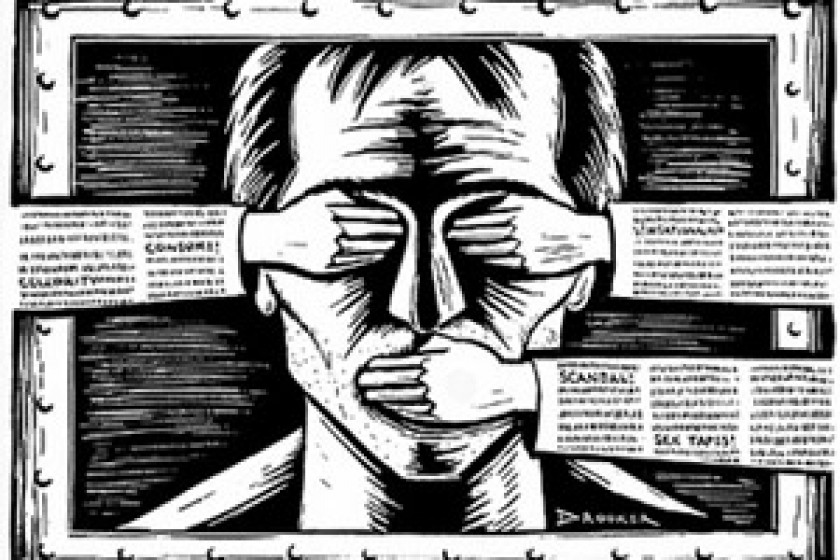
Courts Now Taking a More Balanced Approach Re: Slander Compensatory Damages Against the Media
Starting in January, 2012, the number of slander and insult cases filed against news outlets and reporters began to decrease.
In our opinion, a main factor impacting this process was the RA Constitutional Court’s Decision 997 of November 15 of last year. The courts appear to have begun balancing the scales of justice.
Several officials, who had taken media reps to court, didn’t get the decisions they expected and their demands for large compensation awards were rejected. Several cases filed last year have already been decided and the verdicts show that the courts are inclined to develop judicial practice based on European precedence.
An analysis of judicial verdicts shows that the courts have reviewed their approach, and financial compensation, as a defense mechanism from slander and insult is no longer seen as the only option. Non-financial compensation is also being applied – retracting the questionable article and a public apology.
It would appear that the approach being established is that individuals applying to the courts shouldn’t be financially compensated according to the maximum limits defined, but rather that an individual should be defended from having his/her good name and reputation trampled.
Moreover, restoring ones honour and good name restored via large financial amounts has become risky for plaintiffs. For example, take the case of attorney Artur Grigoryan vs. the Hraparak newspaper.
The attorney had demanded 2 million AMD for each comment he had deemed slanderous, for a total of 18 million. Grigoryan didn’t take into account that if he lost the case he’d had to pay state fees that total 360,000 AMD in the general court of jurisdiction. The attorney appealed this approach in the upper courts, arguing that the amount of the fee was unacceptable and that he refused to pay it since his case wasn’t a property demand.
Grigoryan stated that he was arguing a principle of rights and that he only had to pay 4,000 AMD. The Appeals Court rejected his argument and the Cassation Court merely made it known that it agrees with the view of the Court of Appeals.
This approach was welcomed by legal experts who argued that otherwise the courts would have assisted in bankrupting the news outlets by allowing for small fees to be paid to present large compensation demands.
The impact of this approach was immediately felt in ongoing court cases. For example, Lernapat Mayor Vano Yeghiazaryan filed several slander suits with the Vanadzor Court and had registered a number of serious successes before the Constitutional Court’s famous decision. However, in the case of “Vano Yeghiazaryan v Hetq reporter Adrine Torosyan” the mayor lost. Predicting he would lose, Yeghiazaryan withdrew his 1 million AMD demand and merely asked for 1 AMD. In any event, the court threw out the case and obliged Yeghiazryan to pay Torosyan 150,000 AMD for incurred legal fees.
We see that for the most part financial demands have decreased in recent cases. Plaintiffs aren’t taking advantage of demanding the maximum allowed by the law since the decisions of the Constitutional Court and the Cassation Court have directed the lower courts to take into account the financial situation of news outlets.
The experience of the last several months shows that those who have demanded large financial compensatory accounts have subsequently withdrew them or substituted them with symbolic figures.
Also encouraging is the fact that courts had already started to decrease the compensatory threshold down from the millions it had reached. The main compensatory demand sought by plaintiffs is now for incurred court expenses. These expenses, which also include attorney fees, have mostly been sustained within reasonable limits. We should note that last year attorney fees also broke the million AMD border.
But there are still exceptions to the above approach showing that the courts have still not completely rid themselves of regarding financial compensation as a method to negate slander.
In the case of “Glendale Hills v Zhamanak”, the plaintiff, a housing developer, demanded that the paper pay 2 million for slander, 500,000 for court expenses, and a retraction of the questionable article.
The court found in favour of Glendale Hills and order the paper to pay 200,000 for slander and 300,000 for court expenses, as well as a retraction. Thus, while the court decreased the amounts, it still exacted hefty damages for the newspaper.
In fact, Armenian courts do not always provide reasons why monetary compensation can serve as defense for individuals from slander and insult.
In the precedents and comments of the European Court it is always stressed that methods of non-monetary compensation should be regarded as the primary manner to rectify damage done by libellous expressions and that monetary award should only be considered when non-monetary damages aren’t sufficient to compensate for the damages sustained.
Summarizing slander and insult cases filed with the courts in the first six months of 2012, we can state:
- As opposed to last year when filers of suits were public figures, in 2012 they were mostly average citizens in whose cases news outlets were included as third parties.
- Officials have pulled back from filing lawsuits since the courts, in their decisions, have stated that they are public figures who should expect less protection.
- The courts have greatly decreased monetary demands, including demands for compensation of court expenses.
- Litigants are now attempting to settle out of court.
- At the same time, the courts of professional organizations, in their decisions against news outlets, have registered that reporters do not always carrying out their duties in a professional and conscientious manner.
 Videos
Videos Photos
Photos




Write a comment